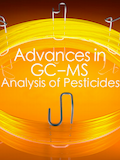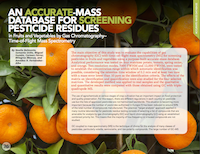An Accurate-Mass Database for Screening Pesticide Residues in Fruits and Vegetables by Gas Chromatography–Time-of-Flight Mass Spectrometry
Spectroscopy E-Books
The main objective of this study was to evaluate the capabilities of gas chromatography (GC) with time–of–flight mass spectrometry (MS) for screening pesticides in fruits and vegetables using a purpose-built accurate-mass database. Analytical performance was tested on four matrices: potato, tomato, spring onion, and orange. Two resolution modes, 7000 FWHM and 12,000 FWHM, were tested to establish the concentration range within which automatic identification was possible, considering the retention time window of 0.2 min and at least two ions with a mass error lower than 10 ppm as the identification criteria. The effects of the matrix on identification and quantification were also studied for the four selected matrices. The developed method was applied to real samples and the qualitative and quantitative results were compared with those obtained using GC with triplequadrupole MS.
Read more here.

Best of the Week: AI and IoT for Pollution Monitoring, High Speed Laser MS
April 25th 2025Top articles published this week include a preview of our upcoming content series for National Space Day, a news story about air quality monitoring, and an announcement from Metrohm about their new Midwest office.
LIBS Illuminates the Hidden Health Risks of Indoor Welding and Soldering
April 23rd 2025A new dual-spectroscopy approach reveals real-time pollution threats in indoor workspaces. Chinese researchers have pioneered the use of laser-induced breakdown spectroscopy (LIBS) and aerosol mass spectrometry to uncover and monitor harmful heavy metal and dust emissions from soldering and welding in real-time. These complementary tools offer a fast, accurate means to evaluate air quality threats in industrial and indoor environments—where people spend most of their time.
